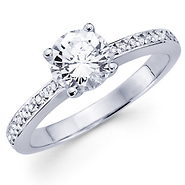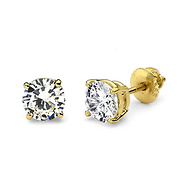|
|
 |
| The Journey of a Diamond |
| Sep-10-2007 |
A rock is just a rock, unless it's a diamond. Globally, an estimated 10 million people are supported by the diamond industry, which makes one wonder what is really involved in the journey of a diamond.
Most diamonds are mined in pipe-like bodies of kimberlite rock and it's not exactly an easy venture. Mined from open pits up to 300 meters deep, an average kimberlite mine contains approximately 25 carats of diamonds for every 100 tons of rock, and of those 25 carats, maybe only 5 carats are usable for gems. The remaining diamonds are used in industrial equipment; the diamond drill bit isn't just a pretty name.
 Diamonds can also be found in river or beach gravels where they have accumulated after erosion of kimberlite pipes. The most notable of this type of deposits can be seen in Namibia, located in South Africa. Here, the beach deposits are so rich with natural diamonds that diamonds are mined in huge open sand pits. This mining operation only yields approximately 5 carats of diamonds per 150 tons of gravel, however almost all of those 5 carats are of gem quality. The diamond rich soil does not end at the water's edge. Off the coast, large mining ships are equipped with specialized vacuum apparatus that actually collects rough diamonds from the sea floor. Diamonds can also be found in river or beach gravels where they have accumulated after erosion of kimberlite pipes. The most notable of this type of deposits can be seen in Namibia, located in South Africa. Here, the beach deposits are so rich with natural diamonds that diamonds are mined in huge open sand pits. This mining operation only yields approximately 5 carats of diamonds per 150 tons of gravel, however almost all of those 5 carats are of gem quality. The diamond rich soil does not end at the water's edge. Off the coast, large mining ships are equipped with specialized vacuum apparatus that actually collects rough diamonds from the sea floor.
Diamonds are separated from the rock by various means such as passing the sediments through a grease belt to which only diamonds stick and all else is washed away. Another separation method is passing the sediments through an x-ray beam which causes the diamonds to become fluorescent and thereby easily picked out. No matter what method is used, a final check is always done by hand, through each and every ton of rock mined.
From the mine rough diamonds are separated into two classifications; gem or industrial quality. Of the gem quality stones, the rough diamonds are sorted again according to shape, size, color, and inclusions. 'Inclusions' can be a vague term, but it is meant to encompass the internal flaws of a diamond such as cracks or internal imperfections such as carbon deposits. These inclusions will determine what special care the diamond cutter will need to consider when preparing the final gem.
A diamond cutter must examine the rough stone in order to determine what shape and size to cut the stone. The round brilliant cut is the most popular cut because it enables the cutter to retain as much of the original stone as possible while giving it the most amount of sparkle. Once determined, the cutter will mark the stone for cutting and the rough diamond will be divided by sawing the stone using a paper-thin metal disc which is coated in diamond dust. A diamond, being the hardest natural element, requires another diamond to cut it. While each facet is carefully cut into the stone, diamond dust is produced which is saved and used for further sawing and faceting. A facet is the tiny surface on a diamond that traps light and makes a diamond sparkle. Most round brilliant cut diamonds have 58 facets, more so if the stone is of exceptional size. to retain as much of the original stone as possible while giving it the most amount of sparkle. Once determined, the cutter will mark the stone for cutting and the rough diamond will be divided by sawing the stone using a paper-thin metal disc which is coated in diamond dust. A diamond, being the hardest natural element, requires another diamond to cut it. While each facet is carefully cut into the stone, diamond dust is produced which is saved and used for further sawing and faceting. A facet is the tiny surface on a diamond that traps light and makes a diamond sparkle. Most round brilliant cut diamonds have 58 facets, more so if the stone is of exceptional size.
Once the final gem is cut and polished, it is ready to be graded. Diamond grading can be confusing for most people but it needn't be. The Gemological Institute of America (GIA) was formed in 1931 and is a non-profit institution. They are an educational organization that has a simple and unbiased diamond grading system by which diamonds can be measured. It is important to note that the GIA does not place dollar value on diamonds; it simply reports the weight, proportions, clarity, color and fluorescence of the diamond.
Once graded, the diamonds are purchased by buyers from all over the world to be set into jewelry and sold to the consumer; you. So the next time you peer into a case full of diamonds at the mall and breathe the words 'what's the big deal?', now you'll have an answer. That little sparking gem had a long journey. |
|
|
Posted by Kim G at 1:42 PM - Link to this entry Share this entry |
| < Back to Engagement Rings Archives |
|
 |
|
|
|